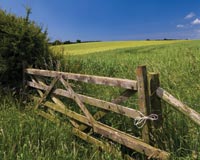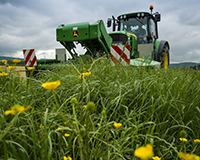 Vast, rumbustious, gossipy events attracting up to seven hundred buyers and gawpers can seem more of the past than of the present. In the more up-to-the-minute rural districts they feel vaguely Victorian; in more remote areas the atmosphere is closer to the medieval Bartholomew Fair.
Vast, rumbustious, gossipy events attracting up to seven hundred buyers and gawpers can seem more of the past than of the present. In the more up-to-the-minute rural districts they feel vaguely Victorian; in more remote areas the atmosphere is closer to the medieval Bartholomew Fair.
Distant cousins, serious buyers, well-wishers and nosey neighbours converge on the farm from miles around. The auctioneer tours the premises, knocking down lots on the spot in the house, barns and out in the yard, always followed by a jostling crowd. Nearby there might be a table loaded with beer, tea and cake; entertainment or rides on tractors for children; and an enormous amount of frantic, noisy, urgent gossiping.
Almost anything can – and does – go under the hammer at a farm dispersal sale, from vast six-figure tractors to rolling pins, chairs, bags of junk and bits of scrap metal. It usually takes a day to clear the farm, and it happens at
amazing speed. Once seen, never forgotten.
Yet they are still the most effective – and often the most financially rewarding – way to bring a farming business to a close. Total annual turnover in farm dispersal sales is not recorded, but best guesses suggest it’s around £40m – perhaps considerably more in years with more sales in arable areas where the higher-value farm machinery is to be found. This is big business.
Yeovil-based Symonds & Sampson hold farm dispersal sales throughout the five counties of Dorset, Devon, Somerset, Wiltshire and Hampshire. This being mainly dairy country, they’ve seen the number of farm sales rocket as falling milk prices put dairy farmers under pressure. From a handful of sales in 1990 they are now handling about 30 a year.
Auctioneer Mark Northcott says: “Dispersal sales are very much an event, very much a part of the way of life. And we’ve had some very large sales in the past 12 months – we’ve grossed more than £500,000 in a few cases. We’ve had some very big attendances, too.”
Northcott has been presiding at farm dispersal sales for more than 40 years, and is convinced they remain a vital business tool for landowners. “Farm dispersal sales work. I know in most of the world these days business is all done electronically, and nobody talks to one another, but the farm dispersal sale still has its place. Half the point of it is meeting up, and they enjoy it,” he says.
 Bernie Hutchinson is also in dairy country, albeit more fortunate financially. He’s been running farm dispersal sales at Barbers in Market Drayton, Shropshire, for 40 years. The dynamics of the local milk business mean fewer sales –
Bernie Hutchinson is also in dairy country, albeit more fortunate financially. He’s been running farm dispersal sales at Barbers in Market Drayton, Shropshire, for 40 years. The dynamics of the local milk business mean fewer sales –
largely thanks to the local presence of Wiseman Dairies, to which many local herds are contracted.
“Farm dispersal sales are an effective tool if you want to clear stock quickly. The vendor knows it will all be gone, even if it may not always raise its full potential price. And it’s very much a social occasion. Neighbours will come to support a local chap going out of business,” he says.
Hutchinson points to one important, but sometimes forgotten, buyer: the farm machinery dealerships. They can often be found bidding for good machinery, and some have a policy of buying their own machines almost regardless, so as to protect their prices and market share. This is particularly significant in the pig business, he says.
Brian Pile, auctioneer at Bletsoes, also has 40 years’ experience, this time in the largely arable counties of Bedfordshire, Oxfordshire, Northamptonshire, Cambridgeshire and Buckinghamshire. Given a few years of high wheat prices, most farmers in this part of the world are doing well and so Bletsoes handles fewer dispersal sales than those in some other districts.
“We have five or six a year, which is a good number for us. We’ve seen smaller sales grossing £50,000 and the larger £250,000,” says Pile. “It’s mostly machinery that pushes up the value, and sales are mostly end-of-career retirement sales. We haven’t done any bankruptcy sales recently.”
Pile says a growing proportion of farm machinery is sold for export, but the bulk of the audience is part of the extended rural community.
“It doesn’t have to be a big catalogue to attract an awful lot of buyers. People come from miles away.”
He adds: “I can’t remember a farm sale that hasn’t been a success. You get all the neighbours there to ensure their friends, who are retiring, get a good send-off – and of course they are also looking for a bargain, which they often don’t find,” says Pile, reflecting on the inflated prices old tractors can fetch (“not even real vintage”).
Farm dispersal sales are, in many ways, a relic of the past. But they are also a living, vital and very effective part of rural business life. Whatever else changes in the next few decades, you
can be sure farm dispersal sales will remain as popular – and successful – as ever.










